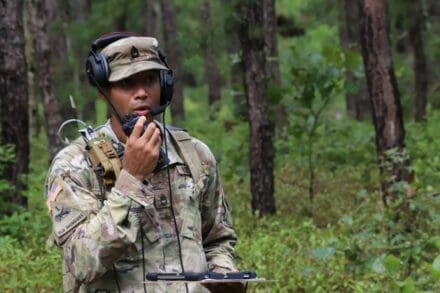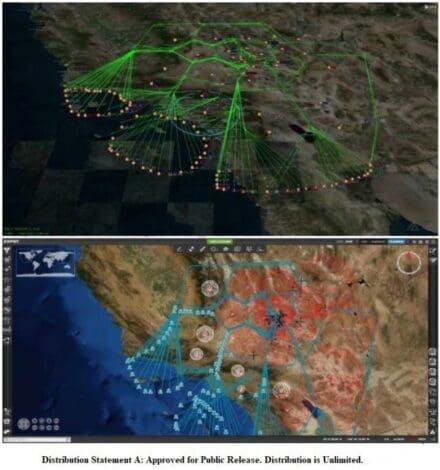ABERDEEN PROVING GROUND, Md. (Feb. 3, 2021) – The Army is improving situational awareness of the electromagnetic battlefield by developing spectrum-sensing capabilities that provide Soldiers with greater awareness of their own radio emissions.

Soldiers currently cannot “see” their own radio emissions within the radio frequency spectrum, putting them at risk of detection by adversaries. The Army’s spectrum awareness effort provides intuitive graphic overlays that enable Soldiers to visualize the energy emitting from their radio frequency systems, said Jonathan Lee, an engineer with the Command, Control, Communications, Computers, Cyber, Intelligence, Surveillance and Reconnaissance (C5ISR) Center – a component of Army Futures Command’s Combat Capabilities Development Command.
“Knowing what we look like to the enemy from an electromagnetic perspective is a critical capability at all echelons of the Army,” said Lee. “This technology improves one’s situational understanding of the electromagnetic environment. It will enhance units’ ability to determine if a signal is friendly or malicious, and it will aid in planning maneuvers.”
Spectrum awareness is one of eight promising Army-developed science and technology efforts the Network Cross-Functional Team (CFT) has prioritized to receive research, development, test, and evaluation prototyping funds to move from early research and development to the demonstration and validation phase.

“Today, we need to be more judicious in order to increase survivability, specifically for our command posts where technology that transmits is most dense,” said Chief Warrant Officer 5 Chris Westbrook, N-CFT chief of marketing research and senior technical advisor. “This effort is going a long way to informing network design and our capability sets.”
Fiscal year 2020 is the first year the Network CFT requested and received prototyping funds aligned to science and technology integration efforts in support of future network capability sets.
“The funding is allowing the science and technology community to take the next step in developing spectrum awareness capabilities that will address capability gaps for the Army,” said Lee. “We believed this technology could be further matured to support additional complex propagation environments and support the identification of new and complex signal types. More work has to be done to further improve our situational awareness and understanding capabilities, but this funded effort is a key step in enhancing those for our Soldiers.”
Lee and his team were able to continue growing the capability from a Department of Defense technology readiness level (TRL) 4– which represents component or breadboard validation in a laboratory environment – to a TRL 6, which is a prototype ready for demonstration in an operationally relevant environment. This included further maturing capabilities for actionable intelligence and improved mission planning, such as Electronic Attack Effects Simulator (EAES) and Real Time Spectrum Situational Awareness (RTSSA).
EAES provides near-real time modeling and simulation to compute and visualize the impact of an adversarial electronic attack on a proposed course of action, thus aiding commanders in determining how best to maneuver assets within the battlespace.
RTSSA senses and compares detected spectrum against authoritative assignment data in the Joint Spectrum Data Repository to discriminate between “friendly” and adversarial communications emitters and other unauthorized radio frequency emitters, thus improving the quality of spectrum assignments and command decision support.
The C5ISR Center is partnering with the Network CFT and program executive offices (PEOs) to ensure these maturation efforts are properly vetted early for a viable and smooth transition to a program of record.
EAES, RTSSA and other C5ISR Center spectrum awareness capabilities are slated to be integrated with current and future increments of the Electromagnetic Warfare Planning Management Tool (EWPMT) – a capability under Project Manager Warfare and Cyber of PEO Intelligence Electronic Warfare and Sensors (IEW&S) that supports the commander’s military decision-making process.
“The EWPMT helps mitigate a critical vulnerability gap across most Army formations today: the ability to understand a unit’s friendly ‘foot print’ in the electromagnetic spectrum,” said Lt. Col. Jason Marshall, PEO IEW&S’s product manager for Electronic Warfare Integration (EWI). “This enables electronic warfare officers and electromagnetic spectrum manager Soldiers to inform their commander on how to conduct emission control, which ultimately enhances force protection and command post survivability in near-peer conflict.”
According to Marshall, the capability of widespread spectrum sensing contributes to a more accurate, timely, and tactically relevant understanding of the radio frequency spectrum, providing Soldiers with enhanced mission planning and the ability to inform multi-domain operations.
The C5ISR Center is working with PdM EWI to identify additional capabilities and demonstration needs. Spectrum awareness technologies are slated to be included in the first capability drops scheduled for fiscal years 2022 and 2023.
“The collaboration between the user community, research and development and acquisition is key to identifying what technologies are within the realm of possibility while refining the Soldier’s requirements as the current tactics, techniques, procedures and doctrine evolve,” Marshall said.
By Jasmyne Douglas, DEVCOM C5ISR Center Public Affairs

